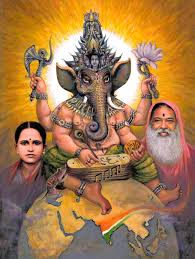Why do we worship God?
When any friends, relatives or guests visit our home, we cordially invite them inside, offer them a seat, some water or juice to quench their thirst. When the visiting guest is elder to us, we worship him/her. We offer them those items of food that they enjoy and take care of their comforts. It is the same with puja.
In a puja, through the invocation mantras, we invite the deity to our house. Thereafter we offer 16 varieties of services and honour the deity.
As the first step, we invoke the deity in our mind and then with full belief and faith invoke them into the puja altar. We then offer water to wash their hands and feet, followed by a seat for them to sit and some juice to quench their thirst. Thereafter, we also reverentially bathe them and offer clothes to wear. We worship the Lord through ashtottara and through offering of other services such as deepa (lighting a lamp), dhoopa (offering of incense stick), naivedya (offering of food). We then sing and dance for the Lord who has come to our house. With total dedication we take all steps to make the Lord feel comfortable in our home. The net result of this activity is the calmness and mental peace that we derive!
The 5 main elements are utilized for the puja offering. How?
The ‘fire’ element is united in the oil as well as the flame; the ‘air’ element is utilized in the incense (dhoopa); the ‘earth’ with the place where the individual is seated; water with the offerings to God during abhishekha and space is all-pervasive.
The ringing bell is to awaken the devotee who is totally drowned in these materialistic worries and anxieties and aid in focus better on the deity. Ringing the bell also helps in driving away demonic vibrations and filling the place with positive vibrations. Hearing the sound of the ringing bell, the mind of the devotee readies itself for worshipping the Lord and thus concentrates better.
The mantras uttered during puja are explicitly important as they are the seed letters (beejaksharas).
The offering of fruits, flowers, coconut and the panchamrta to the deity during a puja have each got a special significance. Panchamrta (5 nectars) contains milk, yoghurt, honey, sugar and clarified butter.
Fruits signify surrendering the devotee’s heart to the Lord; flowers signify surrendering the mind.
Water symbolizes the tear drops offered by the devotee through true devotion to the Lord. Kumkum (red colour powder) increases the capacity of the human being to grasp intricate spiritual science. The kumkum mixed with grains of rice symbolizes auspiciousness.
Breaking the coconut and offering it symbolizes breaking the ego and offering the mind completely to the Lord. It symbolizes complete surrender. Water that drips from the coconut when broken, signifies the nectar or Supreme Knowledge that dawns as the result of total surrender. The white pulp inside the coconut represents the pure mind that remains in the devotee after having gotten rid of the materialistic impressions and ego. Breaking of a coconut therefore symbolizes breaking worldly attachments and bondages by the devotee.
The camphor is lit during the puja is a prayer from the devotee to the Lord to purify him completely without leaving behind any trace of the sins committed by him. The camphor aarati is shown to all the persons who have assembled for the puja. Through this all these assembled persons also pray to the Lord to purify them and rid them of all their sins.
During pradakshina the devotee turns around facing all directions. This reiterates the fact that the Lord is omnipresent and therefore exists in all the directions. Falling flat on the ground in prostration (shashtanga namaskara) is offering the 8 inner flowers to the Lord.
Puja as well as homa combine 3 activities. Firstly doing a puja is itself karma yoga (yoga of action). Secondly the mind is immersed in bhakti yoga (yoga of devotion). Lastly one can unite with the Lord through jnana yoga (yoga of knowledge).
Puja is thus a yoga; a meditation. It is a spiritual science. It is a scientific method to train the mind to remain in single focused concentration at a point. It is also a training to control the mind from wavering. A quietened mind helps the person experience the inner bliss. Deriving bliss through concentration is itself puja.
Pujas as well as homas are beneficial not only to the person performing them but also to the entire world! The positive vibrations generated from them travels to the nearby surroundings. These procedures aid in the path of achieving self-realization.
Bhaktimala Nov 1980, Feb 1987, Jan 1989
